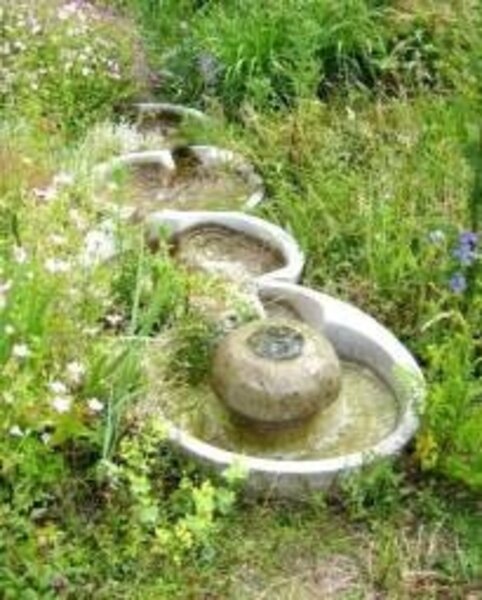How to choose a pump for a small water feature
Do you really need a pump for a water feature in a container? Small water plants will do very well growing in still water — in fact, water lilies require it — so a pump is not always necessary.
However, if you’d like the sound of water splashing in your garden, you’ll need a recirculating pump. You could try a solar-powered pump. I haven’t used one yet, but I’ll let you know when I do.
Here’s what I’ve discovered about setting up container water gardens with pumps that require electricity.
Electricity 101
Pumps are often on sale in fall, so shop now for next spring. Fall also gives you time to do your electrical homework. The outdoor receptacle — it should have a weather-proof cover — must have a ground-fault interrupt (GFI). If your receptacle doesn’t sport those little red/blue buttons, a qualified electrician can install one.
You’re dealing with water and electricity — this is a vital precaution, not an option.
Most of the smaller pumps use energy-efficient magnetic drives. Choose one that is rated for outdoors. Your pump should have a three-pronged plug. Look for a type with a long heavy-duty cord — they vary from 6 to 15 feet. You need a cord of generous length in order to make a safety loop.
Here’s how you make this loop: Position the pump at the approximate level it might be in the container and trail the pump cord over the side — you can later disguise it with water plant foliage.
Allow the cord to drape down below the outdoor receptacle so that it forms a loop of several inches before going back up into the box. That way, no moisture should ever roll straight down the wire and into the plug. If the cord is too short to make a safety loop, don’t use that particular pump in that location.
Measure a rough approximation with a piece of string before you buy to make sure the length meets your needs. You’d be surprised how many pump installation instructions leave out this important bit of information.
Sizing up your situation
Pump prices are directly correlated to how much water the pump can lift — also referred to as the “head.” For a simple bubbler or short spray, I like the smallest gallons per hour (GPH) I can find. My pumps are around 60 GPH. Pumps can also be rated in gallons per minute (GPM) so, of course, 60 GPH=1 GPM.
Smaller pumps are less costly, and I can change how high they bubble, depending on how deep I place them in the water. I don’t want a lot of splash, because, while it sounds dramatic, you end up refilling the container to make up for what’s gone overboard. And it’s surprising how much water you can lose in those little droplets. A gentle bubble or straight up splash of a few inches works well.
I find the GPH suggestions on the back of the pump boxes do not correspond with real-world actualities — a bit like EPA gas mileage. So if a small pump meets all my safety requirements, that’s good enough.
It’s great if the pump has a variable speed on it to control water flow, but if it doesn’t and it’s too forceful, I punch one or two holes in the short tubing line that guides the water from the pump. That diverts some away.
I use the hole punch that came with my drip system, and if the holes reduce the flow too much, I just put a goof-plug in one of them. Or simply replace that piece of flexible tubing. Not very scientific, but pragmatic experimentation goes a long way — and it’s fun.
Place your pump so you can easily access and clean it. I have seen instructions in water gardening books to run the pump cord out the bottom of a container, sealing the hole with silicone, but that makes no sense to me.
I want to take my pumps out, clean them, replace them, or store them for winter. I also put pumps inside fine mesh filter bags that keep out floating debris — good even if the pump has its own filter.
Small water features are the perfect place to get your feet wet, so to speak, with water gardening. I encourage you to experiment, try out what you like on a miniature level —f ailures won’t cost you much, and the whole system is flexible.
The pleasures of water containers are many — such as the first time a tiny green frog decides to take up residence in the water garden you created.
Mary-Kate Mackey, co-author of "Sunset’s Secret Gardens — 153 Design Tips from the Pros" and contributor to the "Sunset Western Garden Book," writes a monthly column for the Hartley Greenhouse webpage and numerous articles for Fine Gardening, Sunset, and other magazines. She teaches at the University of Oregon’s School of Journalism & Communication. She will be writing about water in the garden for Diggin’ It.
Editor’s note: To read more by Mary-Kate, check our blog archive. Gardening articles on a variety of topics can be found at the Monitor’s main gardening page. Also see our RSS feed. You may want to visit Gardening With the Monitor on Flickr. Take part in the discussions and get answers to your gardening questions. If you join the group (it’s free), you can upload your garden photos and enter our next contest.





